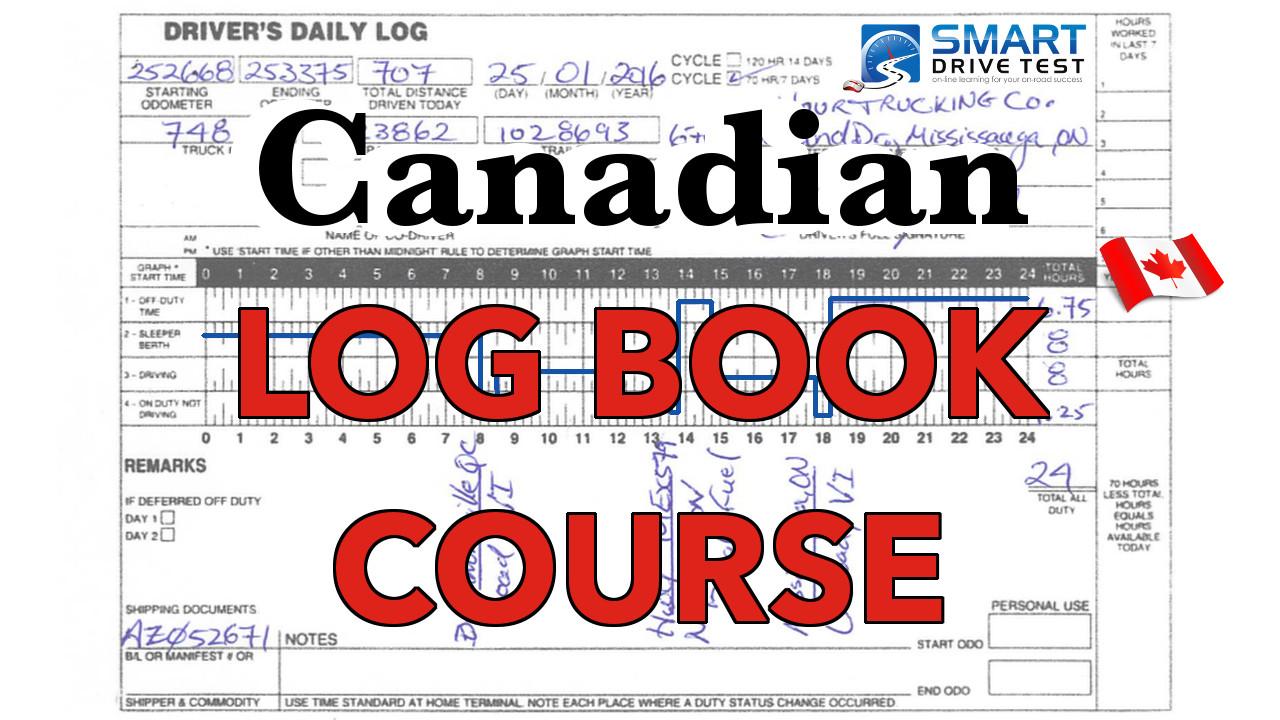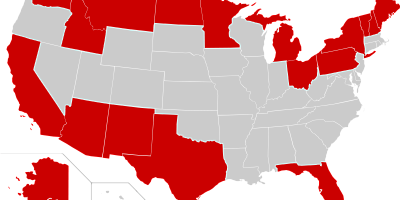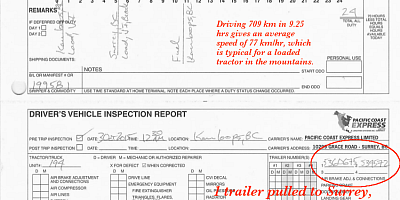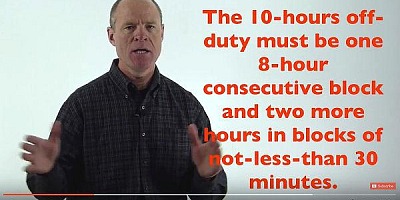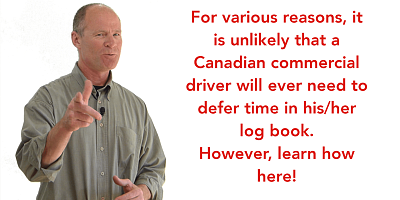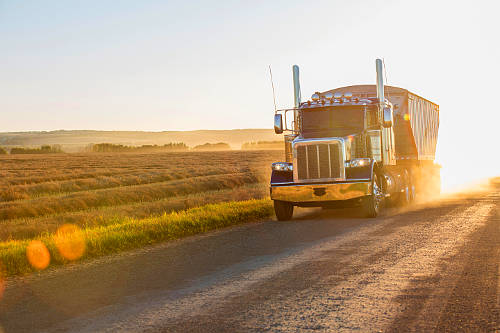Trip planning is an integral skill for professional truck & bus drivers.
Truck & Bus Driver Trip Planning—CANADA | Trucking Smart
Updated Jan 2021
Introduction
Hi there smart drivers! Rick with Smart Drive Test talking to you today about route planning or sometimes called trip planning in Canada.
This is mostly for regional and long haul drivers who are going to be gone overnight or for days at a time.
Essentially when dispatch gives you your information about where your drops are, you plug that into Google maps--my favourite piece of software on the internet in this day and age--to figure out how long the trip is, where your drops are, and how long each leg of that trip is going to take you.
Buy Canadian Logbook Course
Lessons
• Fill Out the Form
• Fill Out the Graph
• Canadian Hours of Service Regulations
• Work Cycle Calculations
• Fatigue Management
• Supporting Documentation
• Trip Planning
1) Module One
• Lessons
2) Module Two
• Exercises
3) Module Three
• Final Quiz & Certificate
Toolkit
• blank logsheets
• work cycle calculator
• logbook check list
• route planning cheatsheet
Now when you get dispatched, you may get some of the information, you may get all of the information.
In my experience, most of the time I'd only get part of the information.
So what happens is I get the outbound freight, and as you're out dropping off the freight--as you probably will--dispatch is working on getting you another load, or whomever the load coordinator is, to bring freight back.
So when you get to your final drop on the way out, they'll say, okay we have another pickup for you.
Head up there and get that.
So today we have a trip planned for you from Kenora, Ontario—way, way up there in the north.
Yes Kenora is still in Ontario - over to Winnipeg you got a drop in Winnipeg--a plastics manufacturer--and then you head over to Regina.
You have a drop at a farm equipment place--at Brandts--and then you head up to Saskatoon.
You have a pickup in Saskatoon.
By the time you get to Saskatoon, though, you're out of hours, so you overnight at the Petro Pass because that's where you get fuel.
You get fuel there and you pick up your load of pallets in the morning at Costco & head back to Winnipeg.
So that's what we're going to do today...
is we're going to go over to the show you the different legs of that trip.
We'll give you some information about how to do that trip and things that you need to consider - how long it's going to take you and how you figure that according to hours of service regulations in Canada.
And the total kilometers that you going to drive for that trip.
This trip is a 2,100 kilometers, so it's a two-day trip minimum, depending on delays and how fast you get in and out of your drops and pickups and fuelling and those types of things.
It could be a two and a bit days, which is probably more what it's going to be.
So we're gonna head over to the computer.
We'll be right back with that information.
Stick around.
The Trip Plan
Hi there smart drivers, welcome back.
Rick at the computer talking to you today about trip planning or route planning as it is sometimes referred to.
We have a trip planned out for you from Kenora, Ontario over to Winnipeg, Manitoba and then we're gonna head over to Saskatchewan.
First to Regina and then to Saskatoon--two drops--we have a drop in Winnipeg, a drop in Regina and then we have a pickup at the Costco in Saskatoon.
As well, by the time you get to Saskatoon, SK you are going to be out of hours and going to overnight and get fuel at the Pretro Pass there in Saskatoon.
You're probably going to do your pick up in the morning first thing at Costco.
Costco does open quite early and starts receiving and shipping at about 4-430 in the morning.
You might also have an appointment, but you're only picking up recycled pallets in Saskatoon at Costco and taking them back to Winnipeg.
So you can pick those up and that could be loaded on quite quickly and you could be on your way down the road depending on how busy Costco is.
It does get pretty busy in the morning at four, so you might have to overnight in Winnipeg on your way back to Kenora, however with a push you could probably make this trip in two days.
Calculation Time
You do know it is two days because if we look at the details here you can see that the total number of hours in a car or light truck is 21 hours 51 minutes, so you know that the driving time in a big truck--depending on how heavy you're going to be coming out of Kenora, into Winnipeg and over to Regina.
So I would budget probably 25-26 hours for this trip.
Because if it's 22 hours in a car or light truck, it's probably gonna be 25-26 hours of driving time - just driving time in a big truck, depending on how heavy you are.
Now you're on the flat, so it's going to be a little better.
You're probably going to average 85 or 86 km/h for the whole trip.
Drops & Pickups
The determining factor will be your drops and pick-ups.
Those are going to determine how long it's going to take and whether you're going to have to stay over in Winnipeg on the return trip or whether you can push it through and get home in two days.
When you budget for drops and those types of things, budget an hour at each drop.
It could be longer, depending on whether they make you wait in the dock and those types of things.
I have found that that has happened with van trailers - that you end up sitting around for awhile and sometimes you can be up to a couple of hours before you get either unloaded or loaded and on down the road.
Departing Time
So budget that as well to get into the yard in the morning and pick up your trailer and get your paperwork filled out and actually get on the road can take you anywhere from an hour to two hours.
As well, depending on whether the loads ready, you can find the paperwork, your truck & trailer and those types of things.
All of that can have an influence on how much time you need in order to get your truck ready, get your paperwork done, and get on down the road.
Weigh Scale
One of the other factors that's going to influence how long your trip is going to take is whether you get pulled into scales and those types of things.
And some of the busier places are actually going to pull you in and you're going to take some time.
You're not just going to roll over the scale.
There's going to be scales outside Winnipeg & those types of places.
And if you just roll thru, it's not a big deal, it's just a minor inconvenience of pulling off the road, going through the scale and carrying on down the road.
Now if you get pulled in, and they want to look at your paperwork, you're probably gonna have to budget another hour.
Don't Work the Day for Free:: DOT Weigh Scale Checklist |
||
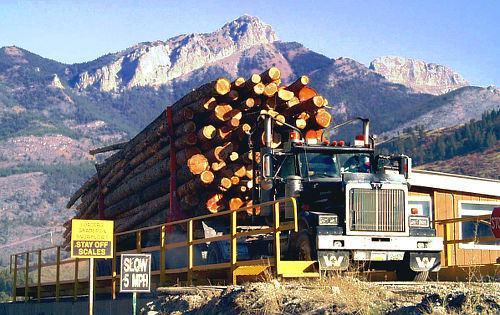
• DID YOU KNOW? :: Bus & truck drivers are the only drivers that have their own police force (DOT, CVSE, MTO, etc.);• SMART :: There's a lot of paperwork you must produce for authorities at the weigh scale;• SELF-CONFIDENCE :: Bring all paperwork in one hit & impress the diesel bears! |
||
Because in most cases, it's you that gets the fine...NOT the company! |
Total Time
So you always want a buffer of time.
So probably just looking at this, 25 hours of driving time - you're probably looking at 30-32, maybe even 35 hours for the whole trip.
Trip Legs
We look at just the overall destinations here, so we've got Kenora, ON, Winnipeg, MB Acrylon Plastics Plastics in Winnipeg.
They're going to do a drop.
We have a drop at Brandt Industries, which is a farm equipment place in Regina, SK.
We're going to Saskatoon to the Petro Pass and then the Costco.
We're going to pick up pallets and we're gonna head back to Winnipeg and then head home to Kenora.
And then we click on the details down here at the bottom, on Google maps and that will give us all the details of where we're going - directions and those types of things.
GPS (Global Positioning Satellite)
Of course, in this day and age, most of you are going to have GPS (Global Positioning Satellite)-- either a commercial version—or are going to have the GPS that's on your phone.
Now know that if you have a phone, it's not a commercial GPS, and will take you down non-truck routes.
Make sure you stay off non-truck routes with big trucks, because unfortunately authorities--police, CVSE (Commercial Vehicle Safety Enforcement), & DOT (Department of Transport)--depending on who is policing trucks, have the right to pull you over and give you a ticket for being on a non-truck route.
So pay attention to that if you're using a GPS that is not a commercial GPS.
Now we can see the first leg of the trip here.
Kenora, Ontario over to Winnipeg is two hours 36 minutes.
It's probably gonna take you three hours - three hours 15 as I said, depending on how heavy you're loaded, if you're pulling Super B's or pulling a tridem trailer, it's gonna take you a bit longer than that.
Even more than if you're just running tandem-tandem.
And then from Winnipeg over to Regina is five hours 48 minutes, which is probably going to be closer to seven hours for you in a big truck.
There you get unloaded and then up to Saskatoon, SK.
Fuelling
We're gonna overnight, you're going to get fuel at the Petro Pass.
And getting fuel can take you anywhere from half an hour to 45 minutes, depending on the size of the tanks on your truck.
If they're 150 gallon tanks, not so long as 300 gallon tanks obviously.
All of these fuelling stations are high pressure hoses and whatnot.
DEF Fluid (Diesel Exhaust Fluid)
As well, you're gonna have to put DEF (Diesel Exhaust Fluid) fuel.
Most newer trucks are all going to have DEF tanks on them-- diesel exhaust fluid and it's just a matter of filling up that tank as well.
There's two fuel gauges on the dash: 1) one is for DEF and one is for regular diesel fuel.
The DEF fuel...one tank of DEF fuel will last about six tanks of diesel fuel, but it's easier to fill that up if you have bulk DEF.
You certainly don't want to be dealing with those jugs that you have to in some truck stops and whatnot.
But you do have to put DEF fuel in and it can take you anywhere up to 45 minutes to get fuel and then get into the truck stop and get parked.
Parking
And just on that note of getting parked and looking for places to park and sleep overnight - you usually want to get into these places fairly early, because in Canada it's much more difficult to find truck stops and parking & those types of things.
More so than it is in the States because of the Interstate system.
And truck stops are just more well developed in the United States than they are in Canada.
Now if you know where you're going, it's not going to be so bad because there's a lot of pullouts and of those types of places that you can park and whatnot.
But in Canada, truck stops for the most part, tend to be in major cities.
And if they do have parking, some of it could be limited.
There are places where if you are not in there by six o'clock at night, there's just really no chance that you're going to get parking in some of these truck stops.
So it's a good idea to know, maybe you can even phone ahead and ask what the parking lot looks like - those types of things.
But parking overnight in a big truck is definitely more challenging in Canada than it is in the United States - so plan accordingly for that as well.
Return Trip
So Saskatoon, and then we're gonna head back.
We're going to pick up our load in the morning, and we're gonna head back to Winnipeg.
And we can see here from the Costco in Saskatoon, back to Winnipeg is eight hours and three minutes and it's probably closer to nine - nine and a half hours, depending on traffic, how heavily you're loaded and those types of things.
You do have a load of pallets on, so you're not going to be too bad in terms of weight coming back to the Costco in Winnipeg.
And again, it's a matter of getting unloaded and how busy they are at Costco and then you might just overnight in Winnipeg and head home to Kenora, ON in the morning.
As you can see here, that the last leg of the trip from Winnipeg back to Kenora is two hours and 44 minutes.
So it's 3-3 1/2 hours, so if you got up fairly early--three, four, five o'clock you could be home by nine, ten o'clock in the morning very easily deadheading from Winnipeg back to Kenora, Ontario.
Conclusion
So in conclusion, today we went over route planning or sometimes called trip planning in Canada.
We plugged everything into for our trip from Kenora, Ontario over to Winnipeg, Manitoba over to Regina, Saskatchawan, up to Saskatoon, SK back to Winnipeg and dead headed home to Kenora.
We figured out that the trip was 2,100 kilometers.
In Canada, according two hours of service regulations, you can drive nine hundred to a thousand kilometers a day, depending on traffic delays, getting in at loading docks and those types of things.
So that's your total distance that you can drive for the day.
Fuel Calculations
The other thing that you have to figure out is the amount of fuel that your truck holds.
In Canada most trucks are going to hold 550 liters of fuel.
Some trucks will hold twice that - they'll have the bigger tanks on them but for the most part 550 litres.
Most big trucks, for the purposes of route planning, you want to figure out 40 liters per hundred kilometers.
So you're going to know that a 550 liter tank on your truck is going to get you about 1,400 kilometers.
So every time you get around a thousand kilometer mark you're going to have to start looking for fuel - to put fuel in that big truck.
Not Less than a Quarter Tank
And just on that note: don't run a big truck less than a quarter tank.
First and foremost, it's for your own safety, especially if you're running in the wintertime and those types of things.
If you end up in the ditch, you want fuel in that truck so you can keep it warm...be nice and toasty while you're waiting for people to come and get you.
The other thing is is that if you let it run below a quarter tank, the sediment and whatnot in the bottom of the tank gets up into the filters and will prematurely wear out your filters.
So keep it above a quarter tank.
Finally we plugged everything into Google maps.
We allowed buffers of time for how long it's going to take you to get out of the yard, how long it's going to take you at loading docks, and those types of things.
We talked a little bit about parking and the challenges of finding parking in Canada.
You're going to overnight in Saskatoon, SK and you're gonna head back to Winnipeg.
Now the other thing that we talked about was the fact that this is two days - probably two and in a bit days because in order to do this trip--2,100 kilometers in two days-- as a is going to be a real push.
So you're gonna overnight in Winnipeg, get up in the morning and then run the three, three-and-a-half hours back to Kenora, Ontario.
So that gives you some information about how to route plan and trip plan when dispatch sends you off in your big truck to deliver freight, pickup freight, and come back.
Dispatch
And again, as a said, dispatch won't give you the whole trip all at once.
Most of the time what's going to happen is you're going to have freight going out and as you're working on dropping off the freight on your way out, they're gonna be looking for a load for you to come back.
Question for my smart drivers:
What software do you use to figure out your route plan and how long it's going to take you to complete a trip after dispatch gives you that information?
Do you use Google maps, use your GPS, your phone or whatnot?
Leave a comment down in the comment section there.
All of that helps out the new drivers that are coming into the industry.

